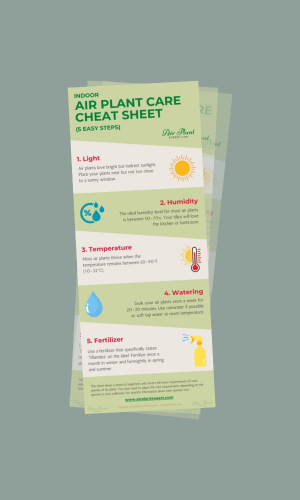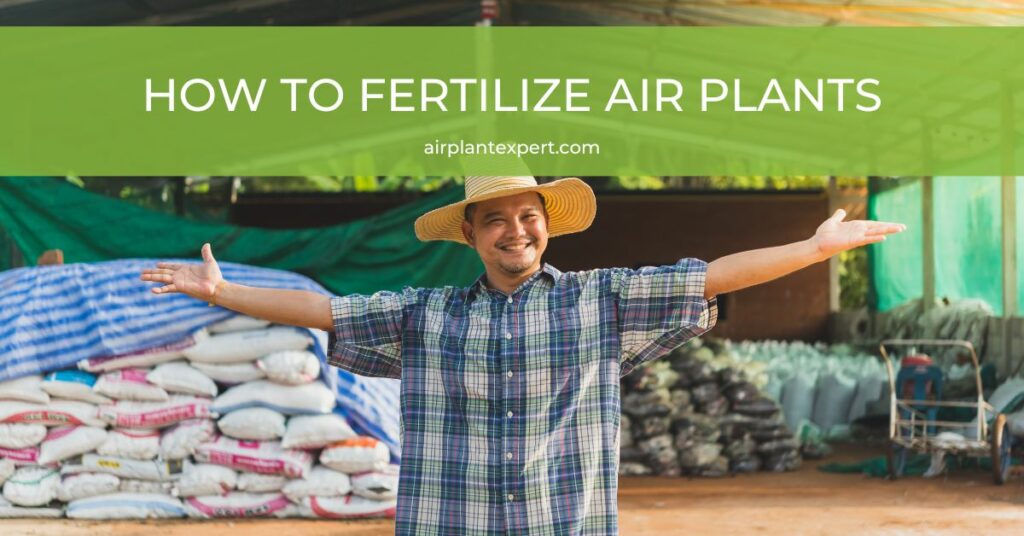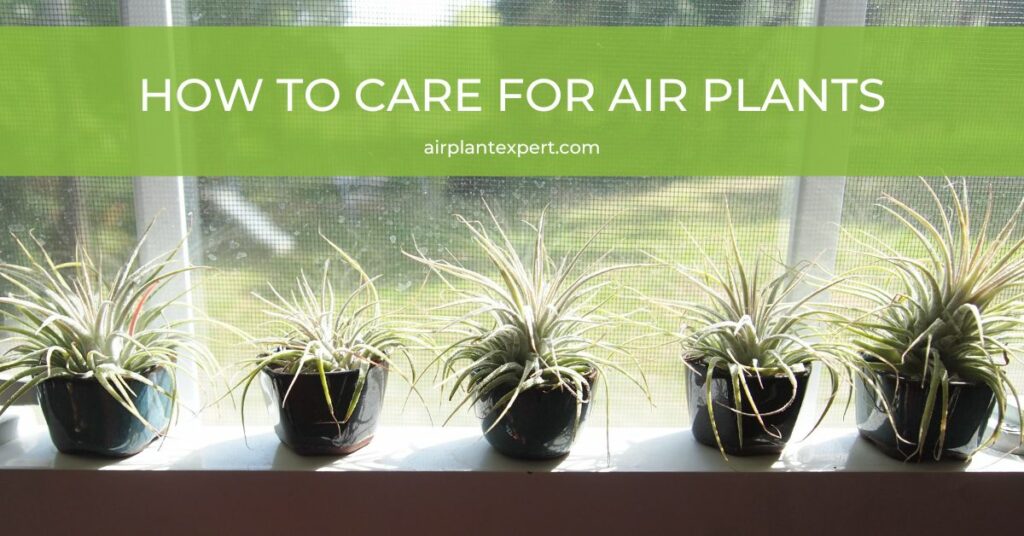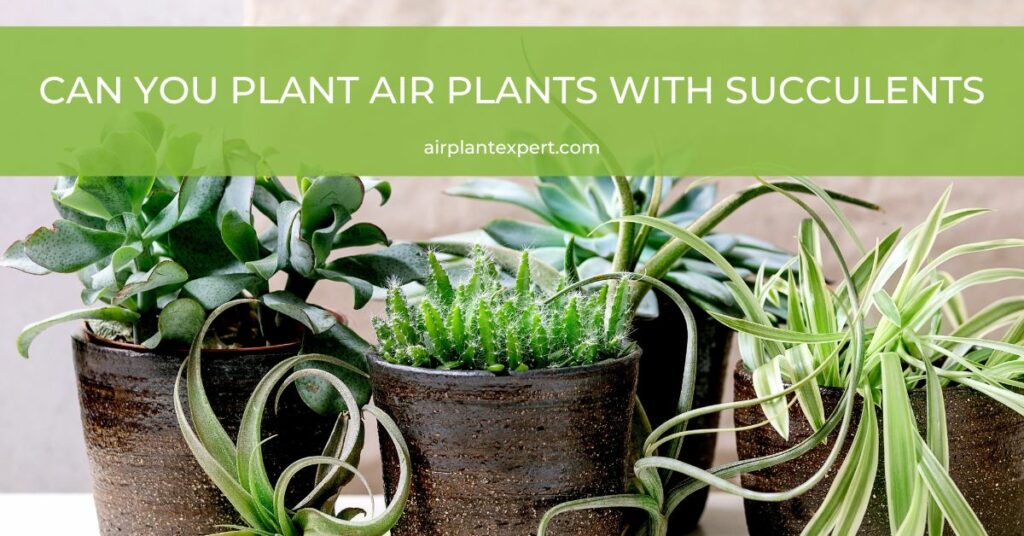You may be wondering how to fertilize air plants properly so they stay healthy and vibrant. I use a pre-mixed liquid fertilizer made specifically for Tillandsia (or Bromeliads) and apply it with a spray bottle once a month during the winter and twice during the spring and summer.
It is that simple. However, you may be wondering which is the best type of fertilizer to buy, or what signs indicate your air plants need more or less fertilizer …
In this guide I am going to show you the best way to fertilize your air plants and just how easy it is to give your plants the nutrients they need.
- How To Fertilize Tillandsia In 3 Easy Steps
- Do Air Plants Need Fertilizer?
- Benefits Of Fertilizing Air Plants
- How Often Should You Fertilize Tillandsia?
- Signs Your Tillandsia Needs Fertilizer
- How Does An Air Plant Take In Nutrients?
- What Is The Best Fertilizer For Air Plants? (best NPK and PH Values)
- Different Types Of Fertilizer For Air Plants
- Tips For Fertilizing Tillandsia
How To Fertilize Tillandsia In 3 Easy Steps
Fertilizing air plants is quite simple! All you need to do is follow these three easy steps and you’ll be on your way to having healthy and flourishing plants in no time.
Before you fertilize your Tillandsia, you need to decide on the easiest method that works for you, misting or soaking. When misting, you simply spray your plant with the fertilizer solution until it is thoroughly wet.
If you choose the soaking method, you submerge your air plants in a bowl/container of the diluted fertilizer solution for 20-30 minutes. There is no right or wrong method. Simply select the method that you prefer and that works best for your beautiful air plants.
Step 1. Preparing The Fertilizer Solution
Once you have selected your method, you can prepare the fertilizer solution. For a water-soluble fertilizer, follow the package instructions very carefully. You can use house plant fertilizer (I don’t recommend this) but it will need diluting first, to at least a quarter of the normal strength.
I prefer to use a pre-mixed liquid fertilizer specifically designed for Tillandsia because house plant fertilizer is usually far too strong out of the box. If you do use house plant fertilizer be sure to mix it thoroughly to ensure a uniform strength. If the concentration of fertilizer is too strong or mixed incorrectly it’s likely you will burn your air plants.
You can purchase pre-mixed liquid fertilizer online or from most garden centers. If you cannot find a product that specifically states ‘Tillandsia’ or ‘Air Plants’ on the label choose a ‘Bromeliad Fertilizer’ instead. Air plants are part of the Bromeliad family so their nutrient requirements are very similar.
Step 2. Applying The Solution
The next step is to apply the fertilizer solution to your air plants. If you have chosen the soaking method, simply fill a container with the diluted fertilizer and submerge your plants in the solution for 20-30 minutes.
If you have opted for misting, like me, use a spray bottle/gun and thoroughly spray your plants with the fertilizer solution until they’re completely wet. As a general rule, fertilize once a month during the winter months, and every two weeks during the spring and summer months.
Step 3. Drying Your Plants
After applying the fertilizer shake off any excess moisture. This is an important step as it helps to avoid fertilizer burn. Then leave your plants to dry off and absorb the nutrients for around 4 hours in a well-ventilated area. If soaking, in particular large plants, it’s a good idea to turn the plants upside down and give them a gentle shake to help remove excess moisture that may be trapped between the leaves. This also helps to prevent rotting.
I often leave my plants to dry upside down or on their sides, it doesn’t damage them as long as you’re careful.
And there you have it – three easy steps to fertilizing your air plants. With just a little bit of effort and care, you can ensure that all of your Tillandsia stay healthy, lush, and vibrant all year round!
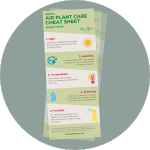
Get Your FREE Air Plant Care Cheat Sheet
5 easy steps to keep your air plants happy and healthy.
Do Air Plants Need Fertilizer?
Yes, air plants need fertilizer/nutrients to grow. However, Tillandsia will of course grow without additional synthetic fertilizers if kept in an outdoor environment. Having said that you could give them a feed occasionally to encourage flowering and healthy growth.
A good air plant fertilizer helps to provide essential nutrients that may be lacking in their environment, particularly if you keep your Tillandsia indoors. Indoor plants tend to grow very slowly and are unlikely to flourish and thrive without the addition of artificial fertilizers. The extra nutrients are essential to encourage healthy and vibrant growth all year round.
Benefits Of Fertilizing Air Plants
I can confidently say that fertilizing air plants provides many benefits, especially for indoor plants. In addition to providing essential nutrients, fertilizer encourages blooming, prevents diseases, fights off parasites and pests, and helps to keep your Tillandisa healthy.
One benefit of fertilizing that is often overlooked is stronger root growth. Strictly speaking, Tillandsia does not absorb water through its roots. However, the root system is important when it comes to supporting the plant, particularly in nature. Additional fertilizer promotes good root growth and allows the plant to attach itself to other objects more easily.
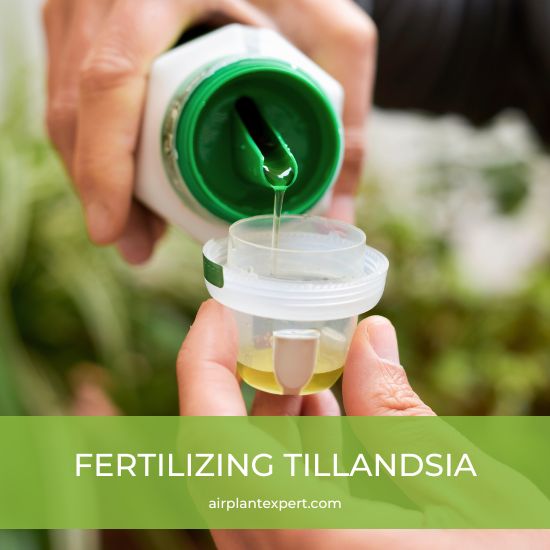
Increasing the amount of fertilizer you use at the right time will encourage blooming and help prolong the flowering period. Tillandsia are known for their amazing blooms and unusual flower spikes so adjusting the amount of fertilizer can yield spectacular results … there’s nothing quite like a Tillandsia in bloom.
How Often Should You Fertilize Tillandsia?
One thing I’ve learned is that when it comes to fertilizing Tillandisa consistency is key! Generally speaking, you should fertilize your air plants once a month during the winter and every two weeks during the spring and summer.
That being said, certain factors can affect how often you fertilize your air plants. For example, if you live in an area with very hot summers or very cold winters, then you may want to adjust your fertilizing schedule accordingly. Just like your watering schedule, your plants need more water/fertilizer when it’s hotter, and less water/fertilizer when it’s very cold.
If your plants are kept in a particularly dry environment or exposed to too much sunlight they may require more frequent feeding and watering as well.
By monitoring the environment around your air plants and adjusting your fertilizing schedule accordingly, you can ensure your Tillandsia stays healthy and maintains optimal growth.
Signs Your Tillandsia Needs Fertilizer
As a Tillandsia lover, one of the most important things I’ve learned is to pay attention to the signs my plants are sending me. After all, if your air plants don’t get the nutrients they need they can start to show signs of stress pretty quickly.
The first sign that something is wrong is when their foliage begins to look pale and weak, which indicates a lack of nitrogen in their diet. Additionally, you may also see chlorosis appear on their leaves – this is where the leaves begin to turn yellow and have darker veins running through them, which indicates they need more potassium in their diet.
You may also notice that your Tillandsia’s growth has slowed down or even stopped altogether during the growing seasons. Small spots can also appear on the leaves resulting in discoloration. All these signs tell you it’s time to give your Tillandsia a dose of fertilizer.
With the right amount of love and nutrients, your Tillandsia will thrive and give you many years of pleasure.
How Does An Air Plant Take In Nutrients?
I’ve always been fascinated by the way air plants take in nutrients. Unlike other plants that need soil to absorb essential nutrients, Tillandsia gets their nutrients through their leaves. They have specially adapted scales/trichomes on their leaves that act as tiny suction cups and allow them to absorb moisture and nutrients from the air around them.
The latest research suggests Tillandsia do absorb some nutrients through their roots, however, they will survive perfectly well without any roots at all, many growers remove the roots for aesthetic reasons.
The main purpose of Tillandsia roots in evolutionary terms is to help the plants to cling to whatever surface they’re growing on.
Misting or spraying air plants with fertilizer is known as foliar feeding, and is the easiest way of providing additional nutrients to your plants.
What Is The Best Fertilizer For Air Plants? (best NPK and PH Values)
The best fertilizer for air plants is one that displays explicitly ‘Tillandsia’ on the label and has a PH value between 5.5 and 6 alkalinity. However, a ‘Bromeliad’ fertilizer is also fine and more commonly found in garden centers. Air plants are part of the Bromeliad family so their nutrient requirements are practically identical.
As I mentioned above, I do not recommend house plant fertilizers, the concentration/solution will be too strong and will likely burn your plants.
After trying many different fertilizers, I’ve concluded that the best NPK values for Tillandsia are 17-8-22. This combination of nitrogen, phosphorus, and potassium is perfect for providing your air plants with the nutrients they need to stay strong and healthy.
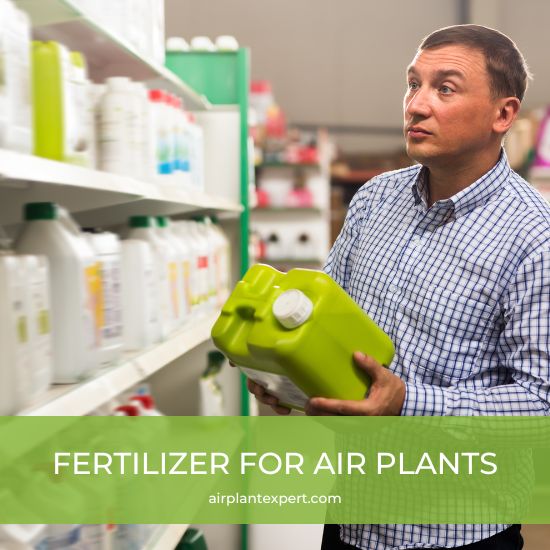
In addition to this NPK formula, it’s important to also make sure that the fertilizer you use has other micronutrients such as iron and magnesium. These additional minerals are essential for creating strong root systems and allowing your plants to absorb moisture from their environment.
When it comes to feeding your air plants don’t forget that moderation is key. Overfeeding can lead to nutrient overdose which can cause stunted growth and fertilizer burn. Make sure you stick to a consistent schedule, and purchase a pre-mixed liquid fertilizer that comes in a spray bottle if you’re looking for the easiest way to fertilize your air plants.
Different Types Of Fertilizer For Air Plants
When it comes to choosing fertilizers for air plants, there are a few different types to consider. No matter what type of fertilizer you choose, just make sure you stick with one that has the right PH or NPK values (nitrogen, phosphorus, and potassium) as well as additional micronutrients such as iron and magnesium.
Liquid Fertilizers
If you’re looking for an easy and convenient way to fertilize your Tillandsia, liquid fertilizers are the best option. With pre-mixed solutions readily available, all you have to do is spray the fertilizer onto every side of your plant. See ‘Foliar Sprays’ below for more information.
Water-soluble Fertilizers
As the name suggests, water-soluble fertilizers are specifically designed to dissolve easily in water, making them another convenient choice. Use non-urea nitrogen. Urea-based fertilizers rely on bacteria in the soil to break down the nitrogen into a usable form, which is of course not suitable for air plants.
Instead, opt for nitrogen that is already in a usable form, such as ammonium or nitrate. Also, avoid fertilizers that contain toxic elements such as boron, copper, or iron, which can be harmful to air plants. If you have to use a house plant fertilizer remember to dilute it first, usually at a quarter of the recommended strength.
Organic Fertilizers
Organic fertilizers are readily available and will provide an additional source of nutrients without impacting the environment around your plants. Organic fertilizers also reduce the likelihood of accidentally introducing harmful chemicals to your lovely plants. So, organic is safer for you and safer for your Tillandsia, it’s a win-win.
Foliar Spray Fertilzers
Foliar spray fertilizers are essentially the same as liquid fertilizers, a pre-mixed solution that contains fertilizer, water, and other micronutrients that can be sprayed directly onto your air plant’s leaves/foliage.
I prefer to use pre-mixed foliar sprays because they’re so convenient. Ready-mixed Tillandsia-specific fertilizers will save you a lot of time and remove the hassle of mixing your fertilizer and the worry of mixing the correct strength. The pre-mixed solution comes in a spray bottle ready to use, you simply shake the bottle a few times and then spray your plants.
With the right nutrient balance and regular fertilization, you’ll have healthy and happy Tillandsia in no time!
Tips For Fertilizing Tillandsia
When using fertilizer on your air plants it is very important to avoid causing damage i.e. fertilizer burn. Here are a few tips to help keep you on the right track:
- Many people ask “Can I use Miracle Grow on air plants?”. The short answer is, no. However, some people do. If you do, make sure you use a very weak solution and don’t blame me if you damage your plants.
- Using a pre-mixed fertilizer can be a more convenient and simpler option.
- Exercise caution when using fertilizer during the winter months. Excessive use can harm the health of your plants.
- Increasing the frequency of feeding during the growing season (spring and/or summer) can help to stimulate blushing and then blooming.
Overall, fertilizing air plants is not too difficult. By following these simple tips, you’re sure to get beautiful results and healthy plants.

